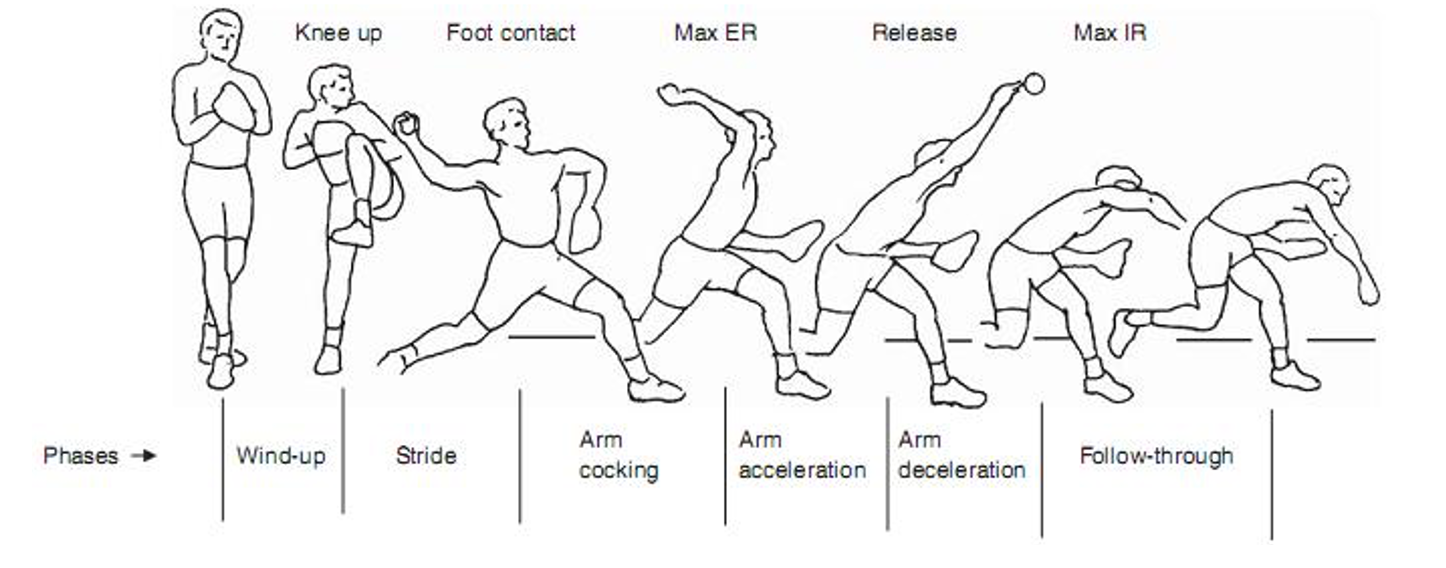Anyone can throw a ball “overhand,” whether a parent having a catch with a child, a pitcher throwing to the catcher, or a pet owner playing fetch with their dog. Even though it may look simple, throwing is a complex set of movements. Six different phases make up an overhead throw, and it is helpful to understand these phases and the muscles involved to improve function and reduce the risk of injury.

Phase 1: The Windup
The windup starts when the thrower is in a double-leg stance and ends when they are in a single-leg stance. Adequate hip muscle activation is essential for appropriate pelvic and lower extremity positioning. The quadriceps allow for slight knee flexion, and the hip abductors, muscles along the outside of the hip, maintain a level pelvis.
Phase 2: The Stride
Stride phase starts when the hands separate at the end of the wind-up and ends when the lead foot hits the ground. The hip abductors of the stance leg initiate forward motion and the buttocks muscle assists in stabilizing the trunk and pelvis.
Phase 3: Arm Cocking
The cocking phase begins when the lead foot contacts the ground and ends at maximum shoulder external rotation. The shoulder and shoulder blade muscles are highly active to promote and sustain movements of the shoulder, especially external rotation. Special focus on instability is important during this phase due to the extreme ranges of external rotation of the shoulder.
Phase 4: Acceleration
This phase begins when the shoulder is fully cocked and ends when the ball leaves the hand. The trunk will move from extension to flexion and the pectorals (pecs) and latissimus (lats) help to internally rotate the arm, eventually leading to release of the ball.
Phase 5: Deceleration
This phase begins when the ball leaves the hand and ends when the shoulder is in maximal internal rotation. The rotator cuff musculature in the back of the shoulder is active in slowing the throwing arm as it crosses the body. Most overuse injuries related to throwing occur during this phase.
Phase 6: Follow-through
This phase occurs when the body weight is transferred to the stride leg, where the thrower decelerates the momentum and balances on one leg. Abruptly stopping the throwing arm without follow-through could cause the shoulder to absorb a larger amount of force and stress, leading to possible injury.
Whether looking to increase performance, mitigate injury, or rehab from an injury, you should seek out a movement specialist, such as a physical therapist who has an understanding of throwing mechanics and can design a treatment program that focuses on deficiencies or limitations specific to the corresponding phases of throwing. Many therapists here at WWSPT have experience treating overhead athletes like football, baseball, and softball players. We have also worked on throwing with adults who experience shoulder pain or who are recovering from an injury or surgery. Don’t throw in the towel when throwing.
Dr Karli Lynch, PT, DPT,
WWS Physical Therapy and Vestibular Rehabilitation
Doylestown, PA.
(215) 489- 3234

Leave a Reply